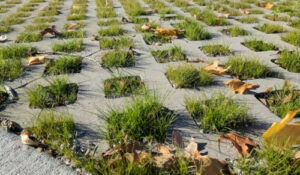By Renee Frith

You may notice some construction across the street from the Visitor Center. We know parking has been a challenge recently, so we’re adding additional parking. BUT, it’s not just any blacktop parking lot. The new lot will be constructed with permeable pavers – a much more green material.
You may be wondering what is a permeable paver. So, here’s your permeable paver crash course:
What are permeable pavers?
A paver that allows water to filter through the paver and into the soil layers below.
What is the difference between permeable and non-permeable pavers?
Permeable pavers allow water to filter into the soil layers below, whereas non-permeable pavers don’t. Water slides off non-permeable pavers – down gutters and into storm drains.

What is the benefit of permeable vs non-permeable pavers?
Think about where we use hard surfaces – roadways, parking lots, sidewalks, etc. Now think about what normally in on these surfaces – vehicles.
With that in mind, think about what each is made of: permeable pavers are made of materials such as brick, cement block, crushed aggregate, etc. Non-permeable pavers are primarily made from a solid surface of cement or asphalt.
The benefit of permeable pavers is that any pollutants such as oil, gas, brake dust, etc. that is left in the parking lot after cars leave will remain until a rain comes. The water from the rain will collects these pollutants, which will then be leached (filtered) down through the permeable pavers and into the soil layers below.
The drawback of non-permeable pavers is that, like permeable pavers, pollutants stay on the surface until the rain comes, but the water from the rain collects these pollutants and carries them through the gutter and down the storm drain.
Why does it matter is pollutants go down the storm drain?
Storm drains catch all storm water run off from non-permeable surfaces. The storm water that is carrying pollutants does not go through a water treatment facility. It goes straight into a nearby body of water. Sometimes it goes into man-made retention ponds, and other times it flows into waterways. That’s right – this is an a-b transaction for pollutants in our waterways.
Side Note: roofs are also a major source of storm water runoff. Green roofs are a solution to reducing roof water runoff, as are rain barrels.
So what happens if the permeable pavers can’t filter all the water?
Great question! There are times of extremely heavy rainfall making it impossible for all the water to filter through the permeable pavers. Any overflow water will travel into an overflow area called a rain garden. This type of garden utilizes plants that can take both wet and dry conditions. The style of this garden is one that can hold water if necessary. The plants’ roots act as a filter for many of the pollutants that the water brings into the rain garden. The water leaches into the soil over time and the process repeats based on rainfall.


